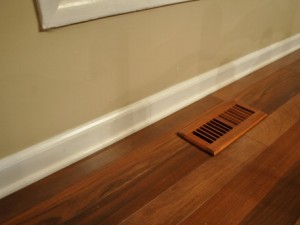How to Paint Over Stained Baseboards and Molding

Many older homes are plagued by baseboards and molding that have been stained and restained many times over the years. What was once a very attractive style in the 70’s or 80’s, has now become dated, dark, and dreary. The good news is you don’t have to replace all your woodwork to freshen things up! Instead, learn how to paint over stained baseboards and molding and brighten and lighten every room in the house. You’ll be surprised at how larger a room will look after you paint over stained surfaces like these.
Instructions
-
1
Anyone can slap on a coat of paint and cover up their dark stained wood. However, if you've ever tried to do this without proper preparation, you know that it doesn't last. If you don't take time to do the job right, you may end up with horrible paint streaks and splotches, or perfectly fine looking results that simply don't last. Here's the right way to paint over stained baseboards and molding.
Materials needed to paint over stained surfaces:
- TSP cleaner
- Soft cloth
- Scrubbing brush
- Stain-blocking BIN primer
- 220 grit sandpaper
- Paintbrush
- Paint roller
- Paint of your choice
How to paint over stained surfaces:
STEP 1 - Thoroughly clean the baseboards and molding before attempting to paint. This can be done by scrubbing them with a mixture of TSP cleaner and water. TSP is available at home improvement stores at an inexpensive price and it removes all traces of grease, dirt, and residue. For best results, scrub the trim work with a scrub brush as you apply the TSP.
STEP 2 - Before continuing with step 2, allow the baseboards and molding to dry about an hour. Then, lightly sand all surfaces with 220 grit sandpaper. This will help give the fresh coat of paint something to hold on to.
STEP 3 - Wipe off the sanded surfaces with a damp cloth and allow it to dry completely.
STEP 4 - It is tempting to begin painting right now, however, this would be a mistake. First, you will need to prime the wood with a BIN prime, which helps removes musty odors and block out stains. It adheres to wood surfaces very well. Apply it with a paint roller for even coverage.
STEP 5 - If your molding and baseboards were stained with an extremely dark color, you may want to apply a second coat of primer to ensure the color doesn't 'bleed' through after painting.
STEP 6 - Now you're ready to paint over stained baseboards and molding. Use the color and finish of your choice. Read our recommendations for choosing the right paint finish and paint color. You will likely have to apply two even coats of paint for a smooth finish.
Doing the job right may take a little time, but it is well worth the effort. You can look forward to enjoying your freshly painted trim work for years to come, without the worry of having to repaint it again soon.


